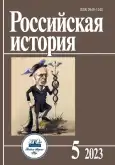Olympic debut of soviet sports
- Autores: Kupriianov A.I.1
-
Afiliações:
- Institute of Russian History, Russian Academy of Sciences
- Edição: Nº 5 (2023)
- Páginas: 154-169
- Seção: Articles
- URL: https://rjsvd.com/2949-124X/article/view/663715
- DOI: https://doi.org/10.31857/S2949124X23050103
- EDN: https://elibrary.ru/OXFSTL
- ID: 663715
Citar
Texto integral
Resumo
Based on archival documents, the article traces the key moments of the long-term process of preparing Soviet athletes for the 1952 Olympic Games. Thanks to the course of the party and state leadership of the country to use the possibilities of cultural diplomacy after the end of the Second World War, Soviet sports come out of isolation, actively use bilateral sports contacts and participate in some World and European Championships. The entry of the Soviet Union into the Olympic movement was hampered by the atychiphobia of Soviet leaders and top sports functionaries, when a defeat in any international competition was seen as damage to the prestige of the USSR. Only in December 1951, the authorities, convinced of the ability of the Soviet Union to compete with the United States for Olympic leadership, agreed to participate in the Olympic Games in Helsinki.
Palavras-chave
Sobre autores
Aleksandr Kupriianov
Institute of Russian History, Russian Academy of SciencesMoscow, Russia
Bibliografia
- Астахова М., Кошелева Л. Дебют СССР на XV Олимпийских играх: Кто принимал решение об участии // Родина. 2014. № 1. С. 67-75.
- Вартанян А. Нас обманывали 50 лет: Олимпиаду-52 все-таки выиграли американцы // Спорт-Экспресс. 2002. 21 октября.
- Гусев С. Первые тульские герои Олимпиады 1952 года умирали в безызвестности (URL: https://tula.aif.ru/sport/football/162702).
- Кузьмин А. Как первый олимпийский чемпион в СССР побеждал американцев на немецкой лодке из красного дерева (URL: https://gorod-812.ru/kak-pervyiy-olimpiyskiy-chempion-v-sssr-pobezhdal-amerikantsev-na-nemetskoy-lodke-iz-krasnogo-dereva/).
- Мидлер А.П. Марк Мидлер. Повесть о фехтовальщике. М., 2016.
- Романов Н.Н. Трудные дороги к Олимпу. М., 1987.
- Сорокин А. Олимпиада-52 в зеркале партийных документов // Родина. 2014. № 1. С. 66.
- Хавин Б.Н. Всё об олимпийских играх. М., 1979.
- Parks J. The Olympic Games, the Soviet sports bureaucracy, and the Cold War: Red sport, red tape. Lanham, 2016.
Arquivos suplementares










